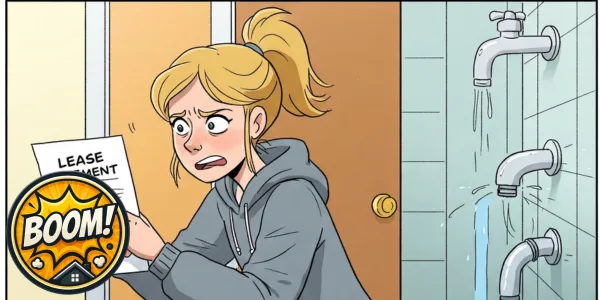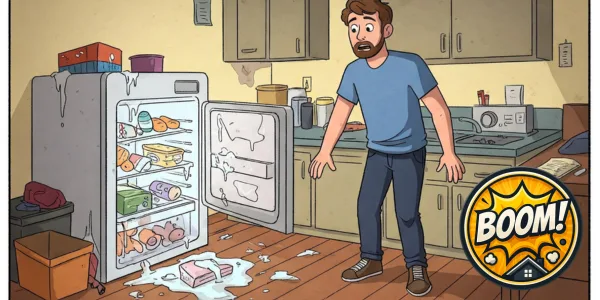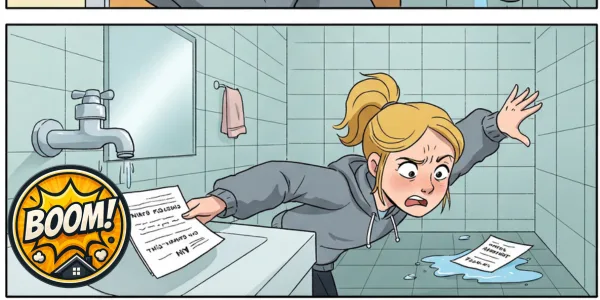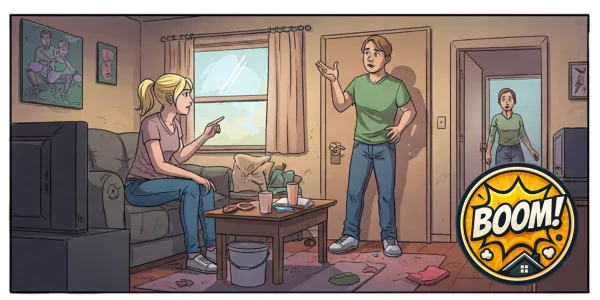Landlord Won’t Make Repairs: What to Do to Protect Your Rights and Home

- Landlord Won’t Make Repairs: What to Do to Protect Your Rights and Home
- Introduction: Why Addressing a Landlord’s Refusal to Make Repairs Matters
- Before You Begin: Key Considerations When Your Landlord Won’t Make Repairs
- Essential Supplies for Handling Renter Repair Disputes
- Step 1: Know Your Tenant Rights and Landlord Repair Responsibilities
- Step 2: Document Repair Issues with Precision
- Step 3: Communicate Repair Requests Professionally
- Step 4: Escalate or Mitigate Issues Strategically
- FAQ: Moving In as a Young Renter
Introduction: Why Addressing a Landlord’s Refusal to Make Repairs Matters
When your landlord won’t make repairs, your rental can turn from a home into a headache, with issues like leaky pipes, broken heaters, or mold threatening your comfort, safety, and wallet. Unaddressed repairs can lead to damages, health risks, or disputes over your deposit. At RepairBoom, we’re here to empower young renters with a four-step plan to tackle landlord repair responsibilities and protect your tenant rights repairs. Our mission is to help you navigate renter repair disputes confidently, ensuring a livable home and saving money.
This guide delivers a renter-friendly strategy to resolve repair issues, covering how to understand your rights, document problems, communicate effectively, and escalate disputes. Download our free Tenant Repair Request Checklist below to make your rental a triumph!
Young renters often face landlords who dodge repairs to cut costs, leaving you with hazards like mold or faulty wiring (a fire risk). Our landlord won’t make repairs guide equips you to fight back, ensuring safety and peace of mind. Let’s dive into the steps to protect your tenant rights repairs!
Before You Begin: Key Considerations When Your Landlord Won’t Make Repairs
Preparation is critical to avoid legal or financial pitfalls in renter repair disputes. Consider these factors to protect your tenant rights repairs:
- Lease Obligations: Your lease details landlord repair responsibilities, like fixing plumbing or appliances. Misunderstanding terms can lead to $100–$500 disputes, per HUD’s tenant rights guide.
- Issue Urgency: Urgent problems (e.g., no heat, leaks) require swift action, as delays can cause $200–$1,000 in damages, per ApartmentGuide.
- Evidence: Without photos or written requests, landlords may deny issues, leaving you liable for repairs, per our Renter Responsibilities guide.
- Local Laws: State laws mandate repairs within 7–30 days for habitability issues. Violations can justify legal action but need proof.
- DIY Risks: Unauthorized fixes, like electrical work, may void your deposit ($500–$1,000). Always get landlord approval.
- Escalation Costs: Legal steps or withheld rent can incur $50–$500 in fees if mishandled.
By planning ahead, you’ll minimize risks and fulfill renter responsibilities.
Essential Supplies for Handling Renter Repair Disputes
Gather these renter-friendly supplies (~$20–$50) to document issues, communicate, and manage temporary fixes:
- Documentation Tools: Smartphone for timestamped photos/videos, notebook for logging requests, and email for written communication.
- Legal Resources: Access HUD’s tenant rights page or local tenant unions for how to report landlord for repairs guidance.

Step 1: Know Your Tenant Rights and Landlord Repair Responsibilities
Knowledge is power when your landlord won’t make repairs. Spend 30–40 minutes reviewing your lease and local laws to clarify landlord repair responsibilities and protect your tenant rights repairs. Your lease’s “maintenance and repairs” section typically requires landlords to fix essentials like plumbing, heating, or structural issues. Look for timelines (e.g., “repairs within 14 days”) or penalties for non-compliance, which can lead to $100–$500 disputes if ignored.
Visit HUD’s tenant rights page or your local housing authority to understand state laws. Most states require landlords to address habitability issues—leaks, broken heaters, or mold—within 7–30 days. For example, New York mandates urgent repairs like no heat within 24–72 hours. Non-compliance can justify withheld rent or legal action, but only with evidence. A renter who overlooked a mold issue faced $1,200 in health costs due to landlord inaction.
If lease terms are vague (e.g., “landlord maintains property”), email your landlord for clarification, storing responses in Google Drive or Dropbox. Use RepairBoom’s Renter Responsibilities page to distinguish your duties (e.g., replacing a smoke alarm battery, per How to Replace a Smoke Alarm Battery in 3 Easy Steps) from landlord repair responsibilities (e.g., fixing a broken heater). Create a checklist of issues (e.g., “leaky faucet reported Nov 1”) and deadlines to track progress. This step builds a foundation for resolving renter repair disputes and prepares you for documentation.

Step 2: Document Repair Issues with Precision
Thorough documentation is your shield when a landlord won’t make repairs, preventing $ false damage claims. Dedicate 20–30 minutes to capturing timestamped photos or videos of each issue—leaky faucets, moldy walls, or broken appliances—using a smartphone with good lighting. Take wide shots for context (e.g., a flooded kitchen) and close-ups for detail (e.g., mold spots), for mold, reference Best Ways to Remove Mold from Bathroom 3 Steps to understand its severity.
Log details in a notebook or digital doc: issue description, discovery date, and impact (e.g., “mold in bathroom since Nov 5, causing allergies”). Store photos and logs in Google Drive, organized by issue (e.g., “Bathroom_Mold_2025”). Email a summary to your landlord with photos, requesting confirmation, to create a paper trail. A renter who documented a broken window avoided a $250 repair charge when the landlord claimed tenant damage.
Update documentation if issues worsen (e.g., a leak spreads). For example, a renter who photographed a growing mold patch secured $800 in landlord-funded remediation. This step, critical for tenant rights repairs, provides undeniable evidence for how to report landlord for repairs.

Step 3: Communicate Repair Requests Professionally
Effective communication can prompt action when a landlord won’t make repairs, avoiding escalation costs. Spend 20–30 minutes crafting a polite, professional repair request. Include your name, rental address, issue description (e.g., “leaky bathroom faucet since Nov 1”), urgency (e.g., “causing water waste”), and a reasonable timeline (e.g., “please repair by Nov 15”). Attach photos from Step 2 and reference your lease or state law (e.g., “per lease, landlord handles plumbing repairs”).
Send the request via email with a read receipt, certified mail, or via an Online Portal saving copies in Google Drive. Follow up every 5–7 days if no response, logging each attempt. A renter who sent three documented requests for a broken heater secured repairs after the landlord faced pressure. Avoid verbal requests—they’re harder to prove in renter repair disputes.
For urgent issues like mold, cite local laws (e.g., “mold must be addressed within 14 days per state law”) and reference Best Ways to Remove Mold from Bathroom 3 Steps for temporary cleaning tips. If the landlord delays, clarify next steps (e.g., “Will a plumber visit by Nov 20?”). This step, pressures landlords to fulfill landlord repair responsibilities.

Step 4: Escalate or Mitigate Issues Strategically
If your landlord won’t make repairs after 7–30 days, strategic escalation or mitigation is key to protect your tenant rights repairs, avoiding damages or health risks.
- Temporary Fixes: For minor, lease-approved issues, consider DIY solutions to maintain livability. Unclog a drain with a plunger (How to Unclog a Drain in 4 Easy Steps) or patch a small hole (How to Patch Wall Holes in 3 Easy Steps) for $5–$20, avoiding $75–$200 landlord charges. Always get written landlord approval to prevent deposit losses ($500–$1,000). A renter who taped a leaky pipe saved $150 in water damage.
- File a Complaint: Contact your local housing or health department to report a landlord for repairs. Provide photos and logs from Step 2. A mold complaint led to $1,500 in landlord-funded fixes.
- Withhold Rent or Repair and Deduct: Some states allow withholding rent for habitability issues (e.g., no heat) or paying for repairs (e.g., $200 for a heater) and deducting from rent. Follow legal steps, like escrow accounts ($50–$100), and consult a tenant union. A renter who deducted a $300 plumbing fix won their case with proper documentation.
- Legal Action: As a last resort, file a small claims case ($50–$200) for repair costs or damages. A renter recovered $900 after suing over a leaky roof.
Contact a tenant union or legal aid for guidance. Document all actions, as errors can weaken your case. For safety issues like a broken smoke alarm, replace the battery (How to Replace a Smoke Alarm Battery in 3 Easy Steps) and notify the landlord.
FAQ: Moving In as a Young Renter
Why is documenting repair issues critical?

Photos and logs prove the issue’s existence, protecting you from $100–$1,000 in false charges. Store evidence in Google Drive, per How to Document Rental Issues.
Can I fix issues myself if the landlord won’t?

Yes, for minor, lease-approved fixes like unclogging a drain.Get written approval and save receipts to avoid deposit disputes.
How do I report a landlord for repairs?

Send written requests with photos, then escalate to housing authorities or tenant unions if ignored
What if repairs affect my safety?

Cite local laws for urgent fixes (e.g., no heat in 72 hours) and escalate to health departments, per HUD’s tenant rights guide.
How to Mount a TV on the Wall in 3 Easy Steps | Free Guide
Renter Move-In Checklist | 5 Free Essential Steps
How to replace a smoke alarm battery | Free Guide – RepairBoom
How to unclog a drain in 4 easy steps | Free Guide – RepairBoom

